EED501 Research in Education TMA2: Methodology, Design, and Threats
VerifiedAdded on 2023/04/08
|12
|2588
|454
Homework Assignment
AI Summary
This assignment solution addresses two questions related to research in education, specifically focusing on research methodology and design. The first question explores the relationship between teaching quality and educational outcomes, employing a quantitative approach with a correlational research design. It details the research questions, data collection methods using online surveys and questionnaires with Likert scales, and sampling techniques based on Cochran's formula. The hypothesis and potential threats to internal validity are also discussed. The second question delves into internal threats to the validity of experimental designs, covering history, maturation, statistical regression, selection, experimental mortality, testing, and instrumentation. Design contamination is also defined. The solution provides a comprehensive overview of the research process, from design and methodology to potential validity issues.
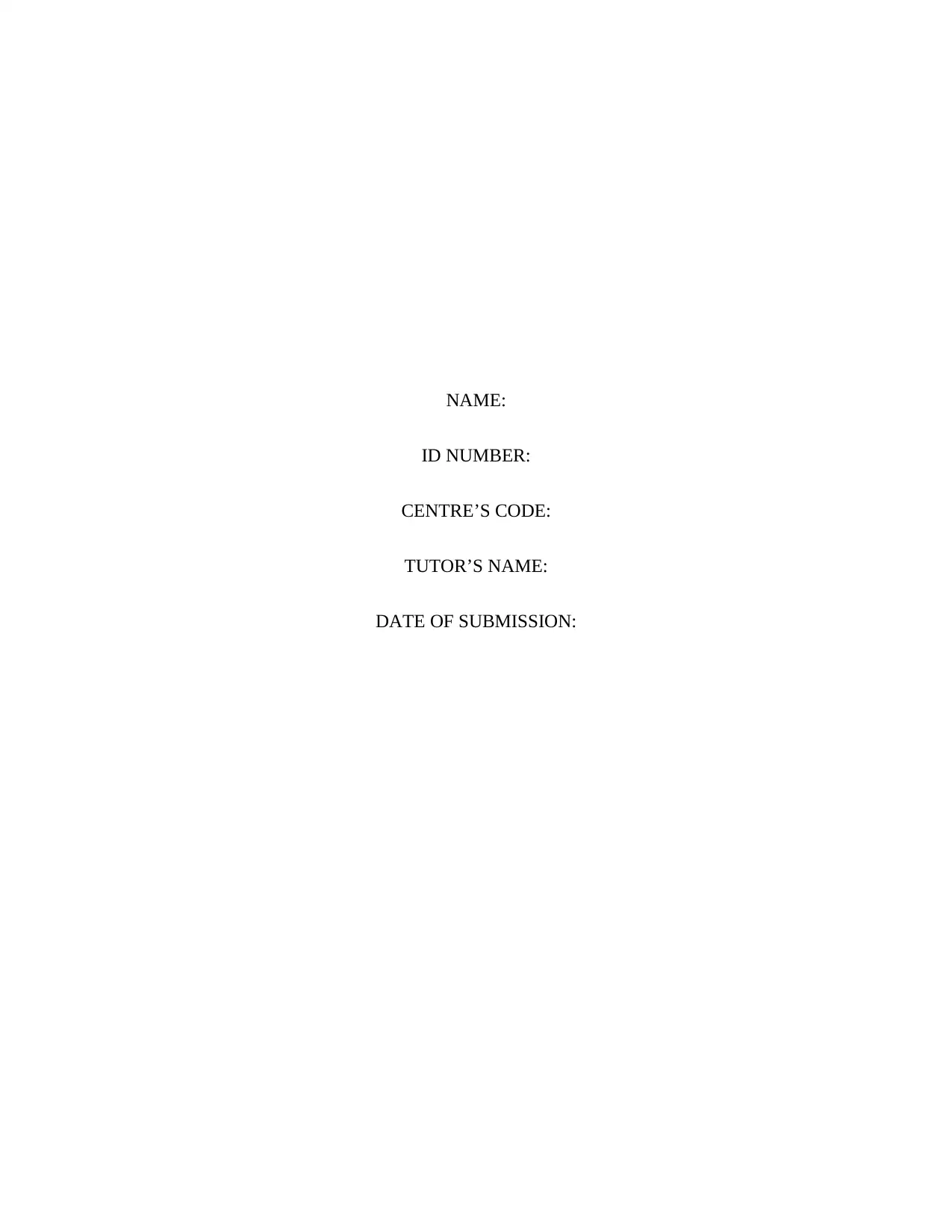
NAME:
ID NUMBER:
CENTRE’S CODE:
TUTOR’S NAME:
DATE OF SUBMISSION:
ID NUMBER:
CENTRE’S CODE:
TUTOR’S NAME:
DATE OF SUBMISSION:
Paraphrase This Document
Need a fresh take? Get an instant paraphrase of this document with our AI Paraphraser
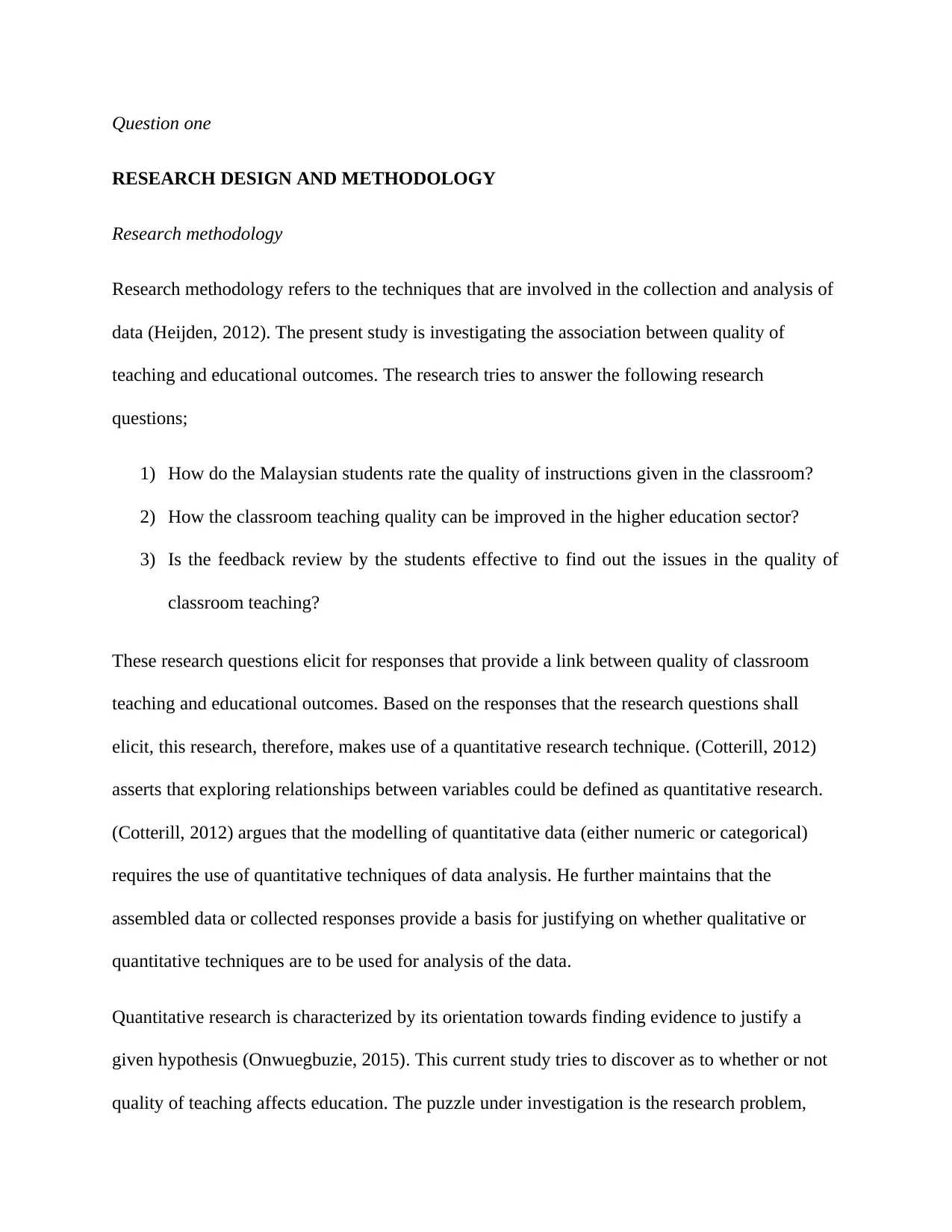
Question one
RESEARCH DESIGN AND METHODOLOGY
Research methodology
Research methodology refers to the techniques that are involved in the collection and analysis of
data (Heijden, 2012). The present study is investigating the association between quality of
teaching and educational outcomes. The research tries to answer the following research
questions;
1) How do the Malaysian students rate the quality of instructions given in the classroom?
2) How the classroom teaching quality can be improved in the higher education sector?
3) Is the feedback review by the students effective to find out the issues in the quality of
classroom teaching?
These research questions elicit for responses that provide a link between quality of classroom
teaching and educational outcomes. Based on the responses that the research questions shall
elicit, this research, therefore, makes use of a quantitative research technique. (Cotterill, 2012)
asserts that exploring relationships between variables could be defined as quantitative research.
(Cotterill, 2012) argues that the modelling of quantitative data (either numeric or categorical)
requires the use of quantitative techniques of data analysis. He further maintains that the
assembled data or collected responses provide a basis for justifying on whether qualitative or
quantitative techniques are to be used for analysis of the data.
Quantitative research is characterized by its orientation towards finding evidence to justify a
given hypothesis (Onwuegbuzie, 2015). This current study tries to discover as to whether or not
quality of teaching affects education. The puzzle under investigation is the research problem,
RESEARCH DESIGN AND METHODOLOGY
Research methodology
Research methodology refers to the techniques that are involved in the collection and analysis of
data (Heijden, 2012). The present study is investigating the association between quality of
teaching and educational outcomes. The research tries to answer the following research
questions;
1) How do the Malaysian students rate the quality of instructions given in the classroom?
2) How the classroom teaching quality can be improved in the higher education sector?
3) Is the feedback review by the students effective to find out the issues in the quality of
classroom teaching?
These research questions elicit for responses that provide a link between quality of classroom
teaching and educational outcomes. Based on the responses that the research questions shall
elicit, this research, therefore, makes use of a quantitative research technique. (Cotterill, 2012)
asserts that exploring relationships between variables could be defined as quantitative research.
(Cotterill, 2012) argues that the modelling of quantitative data (either numeric or categorical)
requires the use of quantitative techniques of data analysis. He further maintains that the
assembled data or collected responses provide a basis for justifying on whether qualitative or
quantitative techniques are to be used for analysis of the data.
Quantitative research is characterized by its orientation towards finding evidence to justify a
given hypothesis (Onwuegbuzie, 2015). This current study tries to discover as to whether or not
quality of teaching affects education. The puzzle under investigation is the research problem,
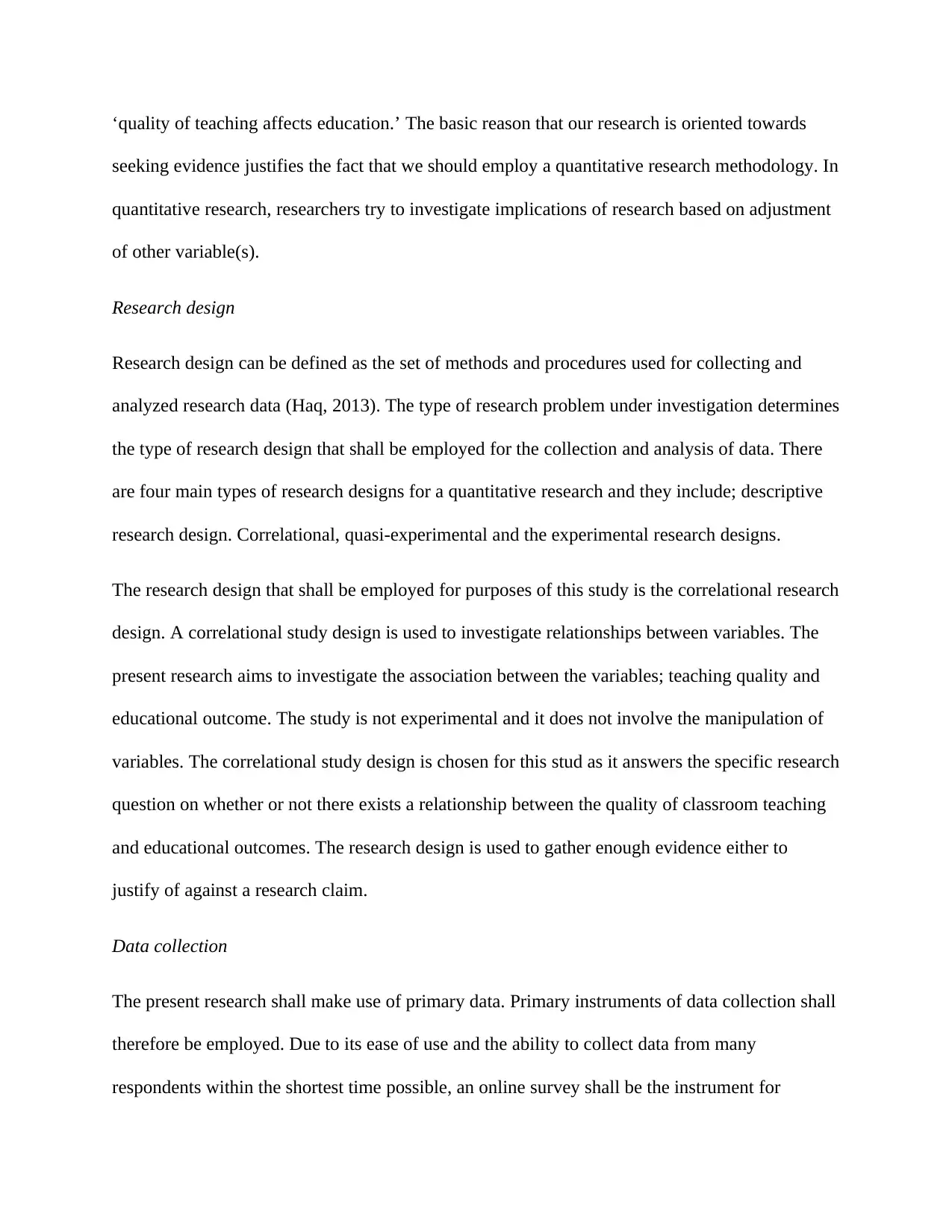
‘quality of teaching affects education.’ The basic reason that our research is oriented towards
seeking evidence justifies the fact that we should employ a quantitative research methodology. In
quantitative research, researchers try to investigate implications of research based on adjustment
of other variable(s).
Research design
Research design can be defined as the set of methods and procedures used for collecting and
analyzed research data (Haq, 2013). The type of research problem under investigation determines
the type of research design that shall be employed for the collection and analysis of data. There
are four main types of research designs for a quantitative research and they include; descriptive
research design. Correlational, quasi-experimental and the experimental research designs.
The research design that shall be employed for purposes of this study is the correlational research
design. A correlational study design is used to investigate relationships between variables. The
present research aims to investigate the association between the variables; teaching quality and
educational outcome. The study is not experimental and it does not involve the manipulation of
variables. The correlational study design is chosen for this stud as it answers the specific research
question on whether or not there exists a relationship between the quality of classroom teaching
and educational outcomes. The research design is used to gather enough evidence either to
justify of against a research claim.
Data collection
The present research shall make use of primary data. Primary instruments of data collection shall
therefore be employed. Due to its ease of use and the ability to collect data from many
respondents within the shortest time possible, an online survey shall be the instrument for
seeking evidence justifies the fact that we should employ a quantitative research methodology. In
quantitative research, researchers try to investigate implications of research based on adjustment
of other variable(s).
Research design
Research design can be defined as the set of methods and procedures used for collecting and
analyzed research data (Haq, 2013). The type of research problem under investigation determines
the type of research design that shall be employed for the collection and analysis of data. There
are four main types of research designs for a quantitative research and they include; descriptive
research design. Correlational, quasi-experimental and the experimental research designs.
The research design that shall be employed for purposes of this study is the correlational research
design. A correlational study design is used to investigate relationships between variables. The
present research aims to investigate the association between the variables; teaching quality and
educational outcome. The study is not experimental and it does not involve the manipulation of
variables. The correlational study design is chosen for this stud as it answers the specific research
question on whether or not there exists a relationship between the quality of classroom teaching
and educational outcomes. The research design is used to gather enough evidence either to
justify of against a research claim.
Data collection
The present research shall make use of primary data. Primary instruments of data collection shall
therefore be employed. Due to its ease of use and the ability to collect data from many
respondents within the shortest time possible, an online survey shall be the instrument for
⊘ This is a preview!⊘
Do you want full access?
Subscribe today to unlock all pages.

Trusted by 1+ million students worldwide
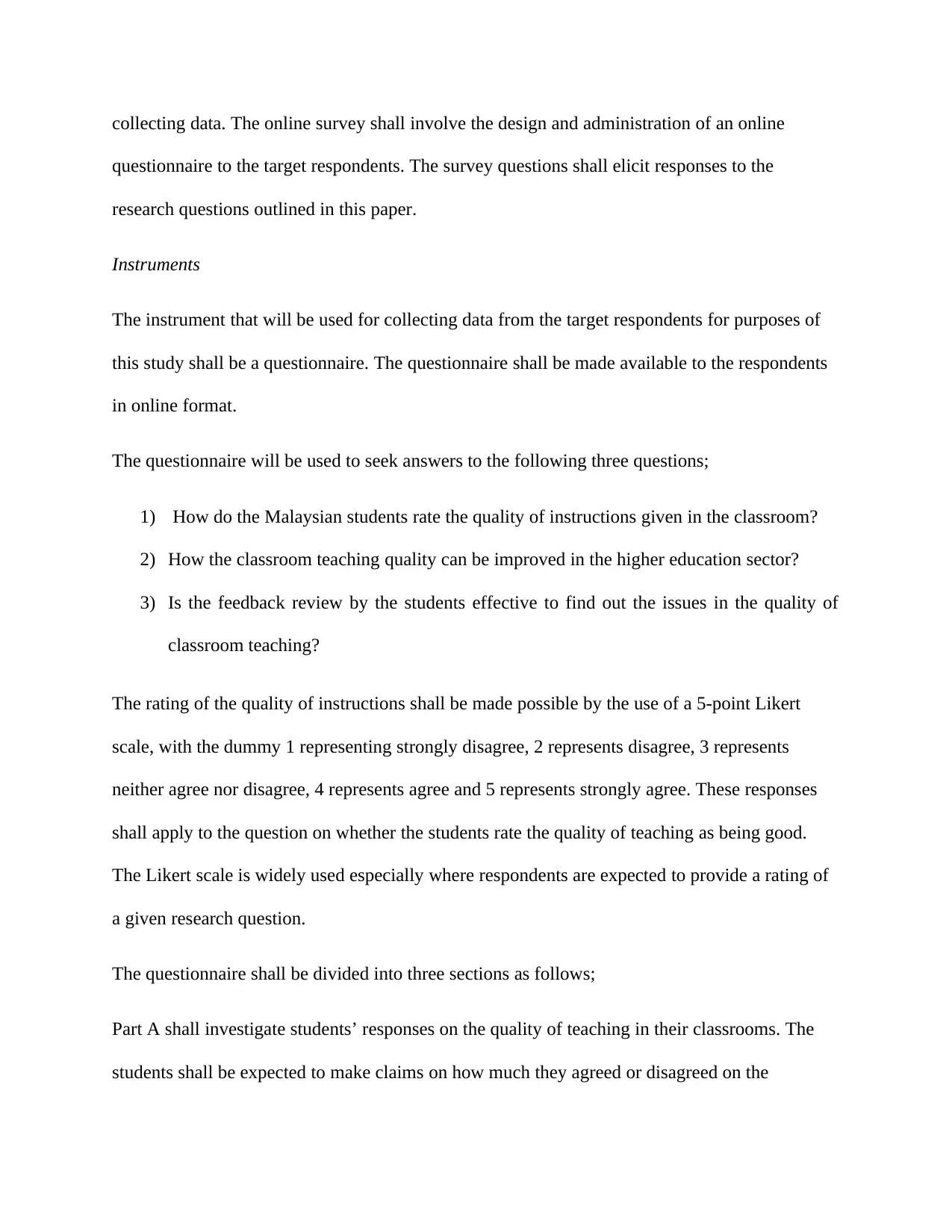
collecting data. The online survey shall involve the design and administration of an online
questionnaire to the target respondents. The survey questions shall elicit responses to the
research questions outlined in this paper.
Instruments
The instrument that will be used for collecting data from the target respondents for purposes of
this study shall be a questionnaire. The questionnaire shall be made available to the respondents
in online format.
The questionnaire will be used to seek answers to the following three questions;
1) How do the Malaysian students rate the quality of instructions given in the classroom?
2) How the classroom teaching quality can be improved in the higher education sector?
3) Is the feedback review by the students effective to find out the issues in the quality of
classroom teaching?
The rating of the quality of instructions shall be made possible by the use of a 5-point Likert
scale, with the dummy 1 representing strongly disagree, 2 represents disagree, 3 represents
neither agree nor disagree, 4 represents agree and 5 represents strongly agree. These responses
shall apply to the question on whether the students rate the quality of teaching as being good.
The Likert scale is widely used especially where respondents are expected to provide a rating of
a given research question.
The questionnaire shall be divided into three sections as follows;
Part A shall investigate students’ responses on the quality of teaching in their classrooms. The
students shall be expected to make claims on how much they agreed or disagreed on the
questionnaire to the target respondents. The survey questions shall elicit responses to the
research questions outlined in this paper.
Instruments
The instrument that will be used for collecting data from the target respondents for purposes of
this study shall be a questionnaire. The questionnaire shall be made available to the respondents
in online format.
The questionnaire will be used to seek answers to the following three questions;
1) How do the Malaysian students rate the quality of instructions given in the classroom?
2) How the classroom teaching quality can be improved in the higher education sector?
3) Is the feedback review by the students effective to find out the issues in the quality of
classroom teaching?
The rating of the quality of instructions shall be made possible by the use of a 5-point Likert
scale, with the dummy 1 representing strongly disagree, 2 represents disagree, 3 represents
neither agree nor disagree, 4 represents agree and 5 represents strongly agree. These responses
shall apply to the question on whether the students rate the quality of teaching as being good.
The Likert scale is widely used especially where respondents are expected to provide a rating of
a given research question.
The questionnaire shall be divided into three sections as follows;
Part A shall investigate students’ responses on the quality of teaching in their classrooms. The
students shall be expected to make claims on how much they agreed or disagreed on the
Paraphrase This Document
Need a fresh take? Get an instant paraphrase of this document with our AI Paraphraser
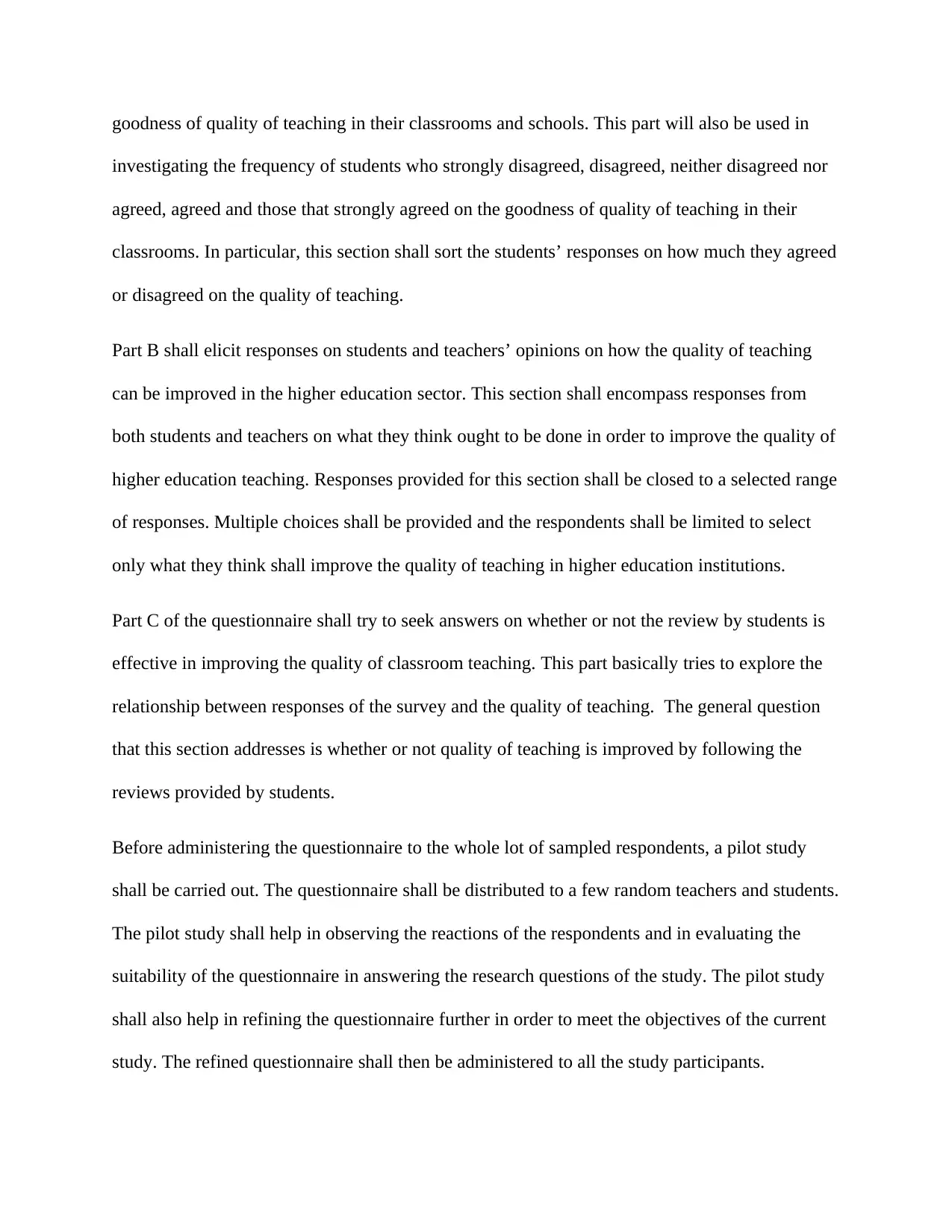
goodness of quality of teaching in their classrooms and schools. This part will also be used in
investigating the frequency of students who strongly disagreed, disagreed, neither disagreed nor
agreed, agreed and those that strongly agreed on the goodness of quality of teaching in their
classrooms. In particular, this section shall sort the students’ responses on how much they agreed
or disagreed on the quality of teaching.
Part B shall elicit responses on students and teachers’ opinions on how the quality of teaching
can be improved in the higher education sector. This section shall encompass responses from
both students and teachers on what they think ought to be done in order to improve the quality of
higher education teaching. Responses provided for this section shall be closed to a selected range
of responses. Multiple choices shall be provided and the respondents shall be limited to select
only what they think shall improve the quality of teaching in higher education institutions.
Part C of the questionnaire shall try to seek answers on whether or not the review by students is
effective in improving the quality of classroom teaching. This part basically tries to explore the
relationship between responses of the survey and the quality of teaching. The general question
that this section addresses is whether or not quality of teaching is improved by following the
reviews provided by students.
Before administering the questionnaire to the whole lot of sampled respondents, a pilot study
shall be carried out. The questionnaire shall be distributed to a few random teachers and students.
The pilot study shall help in observing the reactions of the respondents and in evaluating the
suitability of the questionnaire in answering the research questions of the study. The pilot study
shall also help in refining the questionnaire further in order to meet the objectives of the current
study. The refined questionnaire shall then be administered to all the study participants.
investigating the frequency of students who strongly disagreed, disagreed, neither disagreed nor
agreed, agreed and those that strongly agreed on the goodness of quality of teaching in their
classrooms. In particular, this section shall sort the students’ responses on how much they agreed
or disagreed on the quality of teaching.
Part B shall elicit responses on students and teachers’ opinions on how the quality of teaching
can be improved in the higher education sector. This section shall encompass responses from
both students and teachers on what they think ought to be done in order to improve the quality of
higher education teaching. Responses provided for this section shall be closed to a selected range
of responses. Multiple choices shall be provided and the respondents shall be limited to select
only what they think shall improve the quality of teaching in higher education institutions.
Part C of the questionnaire shall try to seek answers on whether or not the review by students is
effective in improving the quality of classroom teaching. This part basically tries to explore the
relationship between responses of the survey and the quality of teaching. The general question
that this section addresses is whether or not quality of teaching is improved by following the
reviews provided by students.
Before administering the questionnaire to the whole lot of sampled respondents, a pilot study
shall be carried out. The questionnaire shall be distributed to a few random teachers and students.
The pilot study shall help in observing the reactions of the respondents and in evaluating the
suitability of the questionnaire in answering the research questions of the study. The pilot study
shall also help in refining the questionnaire further in order to meet the objectives of the current
study. The refined questionnaire shall then be administered to all the study participants.

Sampling technique and sample size determination
The target population for the study shall encompass both students and teachers. The teachers and
students to participate in the study shall be drawn from a group of randomly selected schools to
participate in the study. The same questionnaire shall be administered to the teachers and
students. The sampled participants shall be expected to answer all questions detailed in the
questionnaire.
The sample for this study is calculated based on the Cochran’s sample size formula. The
Cochran’s formula makes it possible to calculate an ideal sample size given a desired level of
precision, desired confidence interval, and estimated proportion of the section of population
under study.
The Cochran’s formula is given as;
no= ( Z2 pq )
e2 ,
Where e is the desired precision level, z is the desired confidence interval, p-is the estimated
proportion of the population under study and q is (1-p).
We make use of the Cochran’s formula since the population under study (that is, the population
of teachers and students) is very large.
The total proportion of teachers and students is about 35% of the total population.
The sample size for the current study shall therefore be given as;
The target population for the study shall encompass both students and teachers. The teachers and
students to participate in the study shall be drawn from a group of randomly selected schools to
participate in the study. The same questionnaire shall be administered to the teachers and
students. The sampled participants shall be expected to answer all questions detailed in the
questionnaire.
The sample for this study is calculated based on the Cochran’s sample size formula. The
Cochran’s formula makes it possible to calculate an ideal sample size given a desired level of
precision, desired confidence interval, and estimated proportion of the section of population
under study.
The Cochran’s formula is given as;
no= ( Z2 pq )
e2 ,
Where e is the desired precision level, z is the desired confidence interval, p-is the estimated
proportion of the population under study and q is (1-p).
We make use of the Cochran’s formula since the population under study (that is, the population
of teachers and students) is very large.
The total proportion of teachers and students is about 35% of the total population.
The sample size for the current study shall therefore be given as;
⊘ This is a preview!⊘
Do you want full access?
Subscribe today to unlock all pages.

Trusted by 1+ million students worldwide
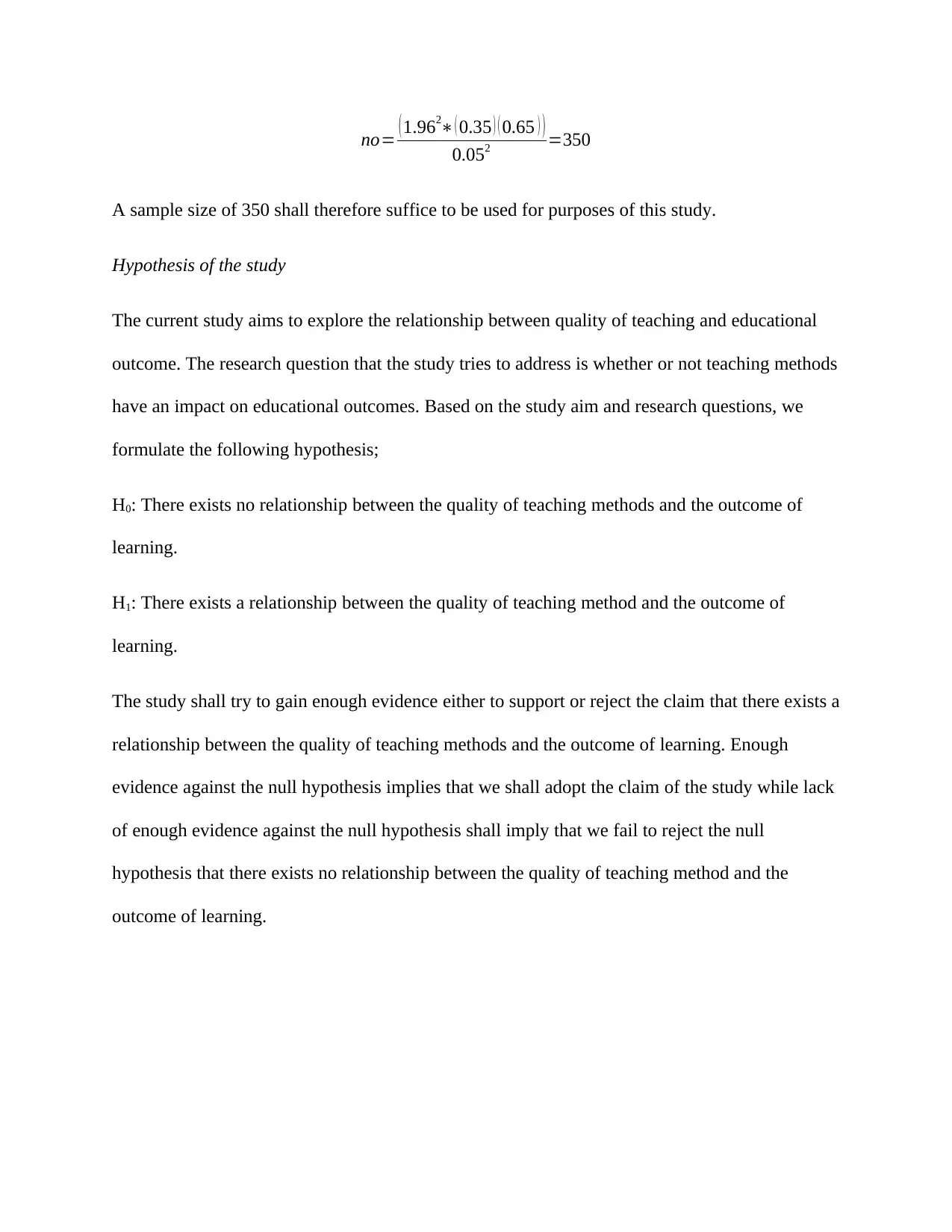
no= ( 1.962∗ ( 0.35 ) ( 0.65 ) )
0.052 =350
A sample size of 350 shall therefore suffice to be used for purposes of this study.
Hypothesis of the study
The current study aims to explore the relationship between quality of teaching and educational
outcome. The research question that the study tries to address is whether or not teaching methods
have an impact on educational outcomes. Based on the study aim and research questions, we
formulate the following hypothesis;
H0: There exists no relationship between the quality of teaching methods and the outcome of
learning.
H1: There exists a relationship between the quality of teaching method and the outcome of
learning.
The study shall try to gain enough evidence either to support or reject the claim that there exists a
relationship between the quality of teaching methods and the outcome of learning. Enough
evidence against the null hypothesis implies that we shall adopt the claim of the study while lack
of enough evidence against the null hypothesis shall imply that we fail to reject the null
hypothesis that there exists no relationship between the quality of teaching method and the
outcome of learning.
0.052 =350
A sample size of 350 shall therefore suffice to be used for purposes of this study.
Hypothesis of the study
The current study aims to explore the relationship between quality of teaching and educational
outcome. The research question that the study tries to address is whether or not teaching methods
have an impact on educational outcomes. Based on the study aim and research questions, we
formulate the following hypothesis;
H0: There exists no relationship between the quality of teaching methods and the outcome of
learning.
H1: There exists a relationship between the quality of teaching method and the outcome of
learning.
The study shall try to gain enough evidence either to support or reject the claim that there exists a
relationship between the quality of teaching methods and the outcome of learning. Enough
evidence against the null hypothesis implies that we shall adopt the claim of the study while lack
of enough evidence against the null hypothesis shall imply that we fail to reject the null
hypothesis that there exists no relationship between the quality of teaching method and the
outcome of learning.
Paraphrase This Document
Need a fresh take? Get an instant paraphrase of this document with our AI Paraphraser
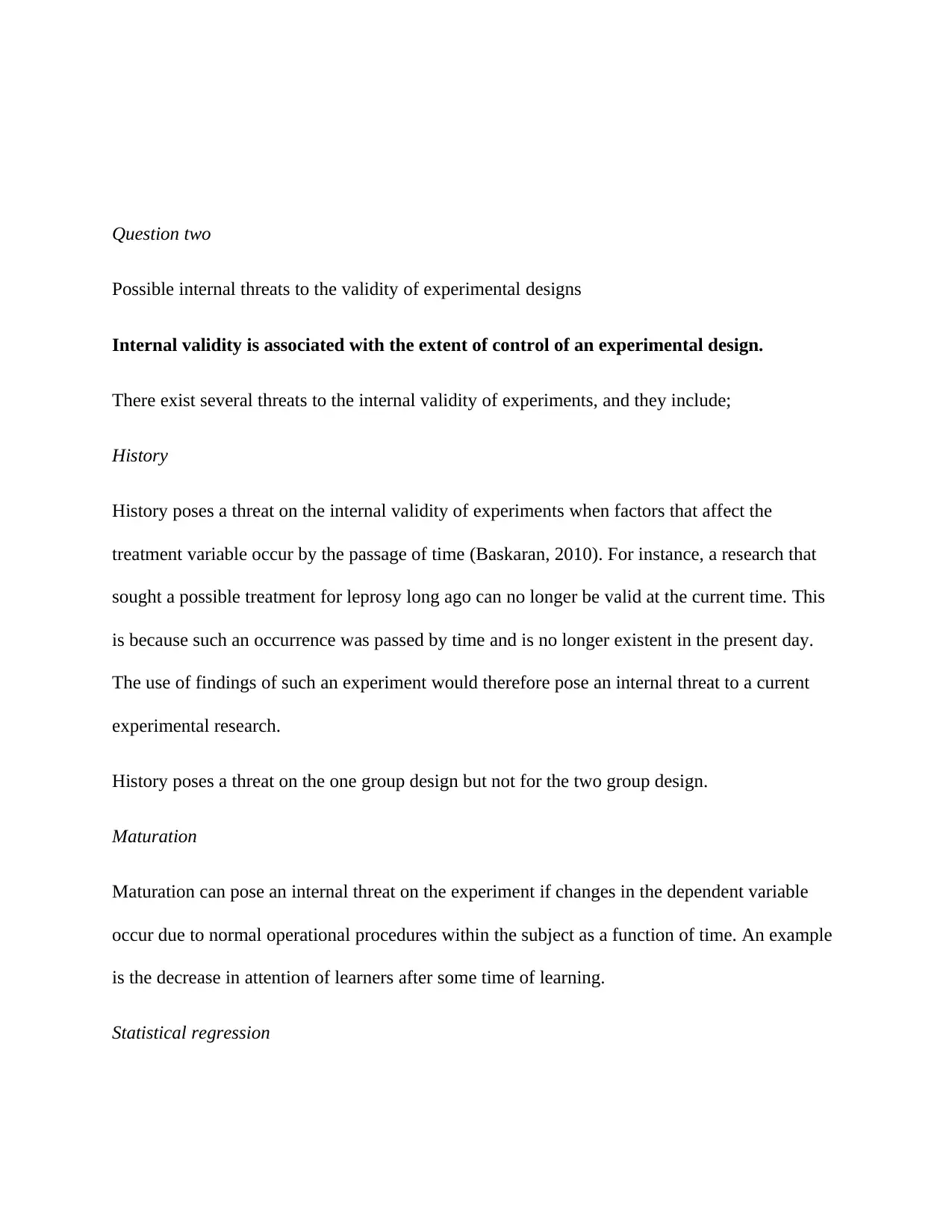
Question two
Possible internal threats to the validity of experimental designs
Internal validity is associated with the extent of control of an experimental design.
There exist several threats to the internal validity of experiments, and they include;
History
History poses a threat on the internal validity of experiments when factors that affect the
treatment variable occur by the passage of time (Baskaran, 2010). For instance, a research that
sought a possible treatment for leprosy long ago can no longer be valid at the current time. This
is because such an occurrence was passed by time and is no longer existent in the present day.
The use of findings of such an experiment would therefore pose an internal threat to a current
experimental research.
History poses a threat on the one group design but not for the two group design.
Maturation
Maturation can pose an internal threat on the experiment if changes in the dependent variable
occur due to normal operational procedures within the subject as a function of time. An example
is the decrease in attention of learners after some time of learning.
Statistical regression
Possible internal threats to the validity of experimental designs
Internal validity is associated with the extent of control of an experimental design.
There exist several threats to the internal validity of experiments, and they include;
History
History poses a threat on the internal validity of experiments when factors that affect the
treatment variable occur by the passage of time (Baskaran, 2010). For instance, a research that
sought a possible treatment for leprosy long ago can no longer be valid at the current time. This
is because such an occurrence was passed by time and is no longer existent in the present day.
The use of findings of such an experiment would therefore pose an internal threat to a current
experimental research.
History poses a threat on the one group design but not for the two group design.
Maturation
Maturation can pose an internal threat on the experiment if changes in the dependent variable
occur due to normal operational procedures within the subject as a function of time. An example
is the decrease in attention of learners after some time of learning.
Statistical regression
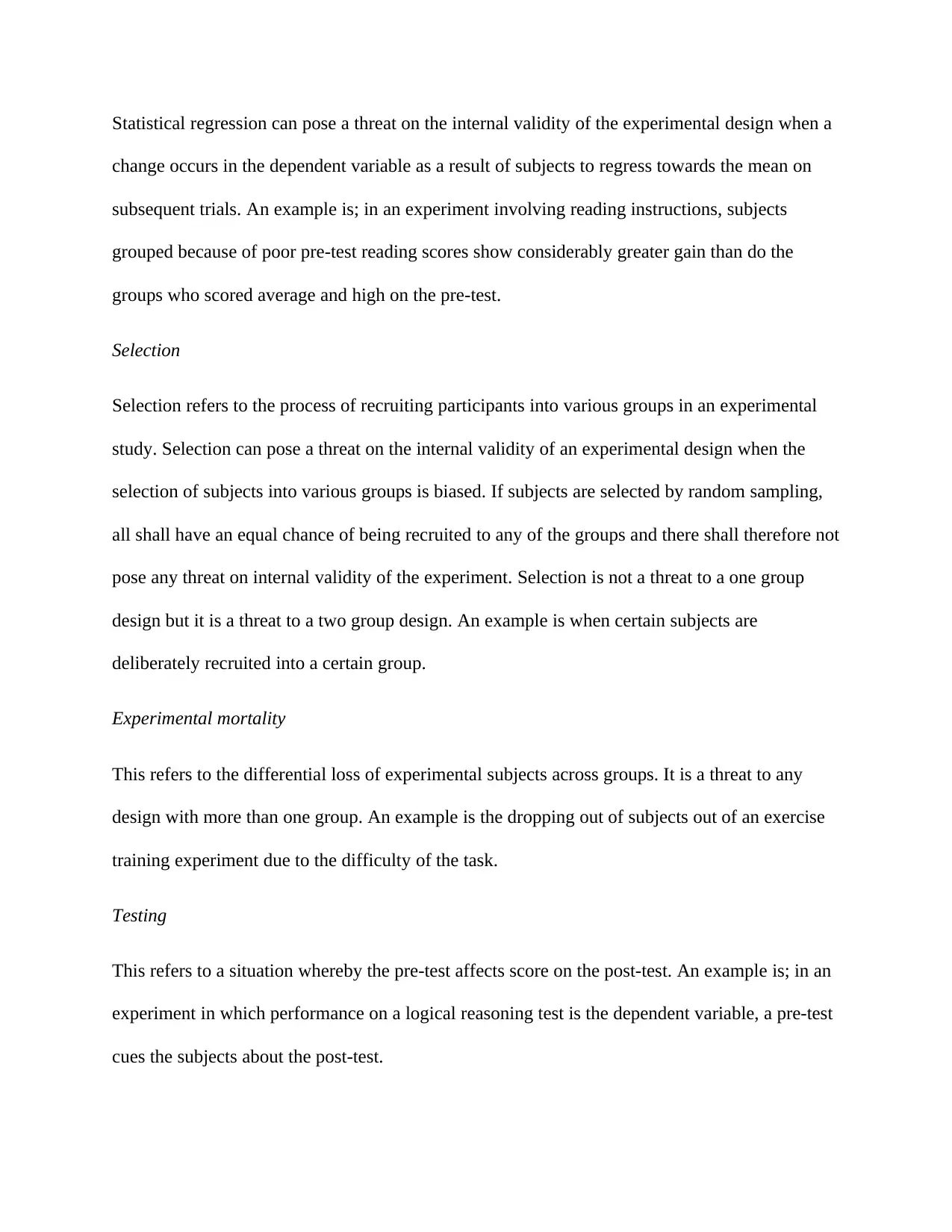
Statistical regression can pose a threat on the internal validity of the experimental design when a
change occurs in the dependent variable as a result of subjects to regress towards the mean on
subsequent trials. An example is; in an experiment involving reading instructions, subjects
grouped because of poor pre-test reading scores show considerably greater gain than do the
groups who scored average and high on the pre-test.
Selection
Selection refers to the process of recruiting participants into various groups in an experimental
study. Selection can pose a threat on the internal validity of an experimental design when the
selection of subjects into various groups is biased. If subjects are selected by random sampling,
all shall have an equal chance of being recruited to any of the groups and there shall therefore not
pose any threat on internal validity of the experiment. Selection is not a threat to a one group
design but it is a threat to a two group design. An example is when certain subjects are
deliberately recruited into a certain group.
Experimental mortality
This refers to the differential loss of experimental subjects across groups. It is a threat to any
design with more than one group. An example is the dropping out of subjects out of an exercise
training experiment due to the difficulty of the task.
Testing
This refers to a situation whereby the pre-test affects score on the post-test. An example is; in an
experiment in which performance on a logical reasoning test is the dependent variable, a pre-test
cues the subjects about the post-test.
change occurs in the dependent variable as a result of subjects to regress towards the mean on
subsequent trials. An example is; in an experiment involving reading instructions, subjects
grouped because of poor pre-test reading scores show considerably greater gain than do the
groups who scored average and high on the pre-test.
Selection
Selection refers to the process of recruiting participants into various groups in an experimental
study. Selection can pose a threat on the internal validity of an experimental design when the
selection of subjects into various groups is biased. If subjects are selected by random sampling,
all shall have an equal chance of being recruited to any of the groups and there shall therefore not
pose any threat on internal validity of the experiment. Selection is not a threat to a one group
design but it is a threat to a two group design. An example is when certain subjects are
deliberately recruited into a certain group.
Experimental mortality
This refers to the differential loss of experimental subjects across groups. It is a threat to any
design with more than one group. An example is the dropping out of subjects out of an exercise
training experiment due to the difficulty of the task.
Testing
This refers to a situation whereby the pre-test affects score on the post-test. An example is; in an
experiment in which performance on a logical reasoning test is the dependent variable, a pre-test
cues the subjects about the post-test.
⊘ This is a preview!⊘
Do you want full access?
Subscribe today to unlock all pages.

Trusted by 1+ million students worldwide
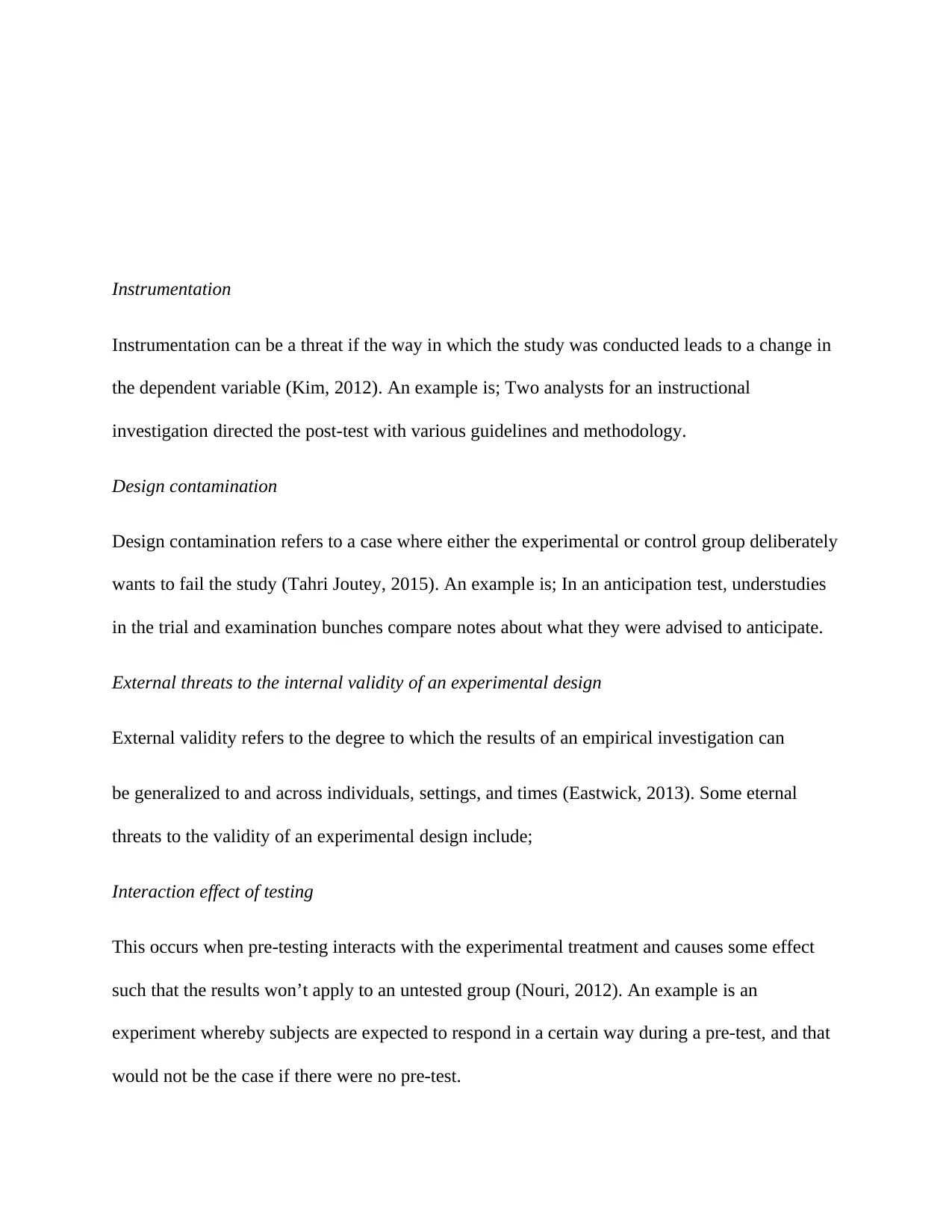
Instrumentation
Instrumentation can be a threat if the way in which the study was conducted leads to a change in
the dependent variable (Kim, 2012). An example is; Two analysts for an instructional
investigation directed the post-test with various guidelines and methodology.
Design contamination
Design contamination refers to a case where either the experimental or control group deliberately
wants to fail the study (Tahri Joutey, 2015). An example is; In an anticipation test, understudies
in the trial and examination bunches compare notes about what they were advised to anticipate.
External threats to the internal validity of an experimental design
External validity refers to the degree to which the results of an empirical investigation can
be generalized to and across individuals, settings, and times (Eastwick, 2013). Some eternal
threats to the validity of an experimental design include;
Interaction effect of testing
This occurs when pre-testing interacts with the experimental treatment and causes some effect
such that the results won’t apply to an untested group (Nouri, 2012). An example is an
experiment whereby subjects are expected to respond in a certain way during a pre-test, and that
would not be the case if there were no pre-test.
Instrumentation can be a threat if the way in which the study was conducted leads to a change in
the dependent variable (Kim, 2012). An example is; Two analysts for an instructional
investigation directed the post-test with various guidelines and methodology.
Design contamination
Design contamination refers to a case where either the experimental or control group deliberately
wants to fail the study (Tahri Joutey, 2015). An example is; In an anticipation test, understudies
in the trial and examination bunches compare notes about what they were advised to anticipate.
External threats to the internal validity of an experimental design
External validity refers to the degree to which the results of an empirical investigation can
be generalized to and across individuals, settings, and times (Eastwick, 2013). Some eternal
threats to the validity of an experimental design include;
Interaction effect of testing
This occurs when pre-testing interacts with the experimental treatment and causes some effect
such that the results won’t apply to an untested group (Nouri, 2012). An example is an
experiment whereby subjects are expected to respond in a certain way during a pre-test, and that
would not be the case if there were no pre-test.
Paraphrase This Document
Need a fresh take? Get an instant paraphrase of this document with our AI Paraphraser
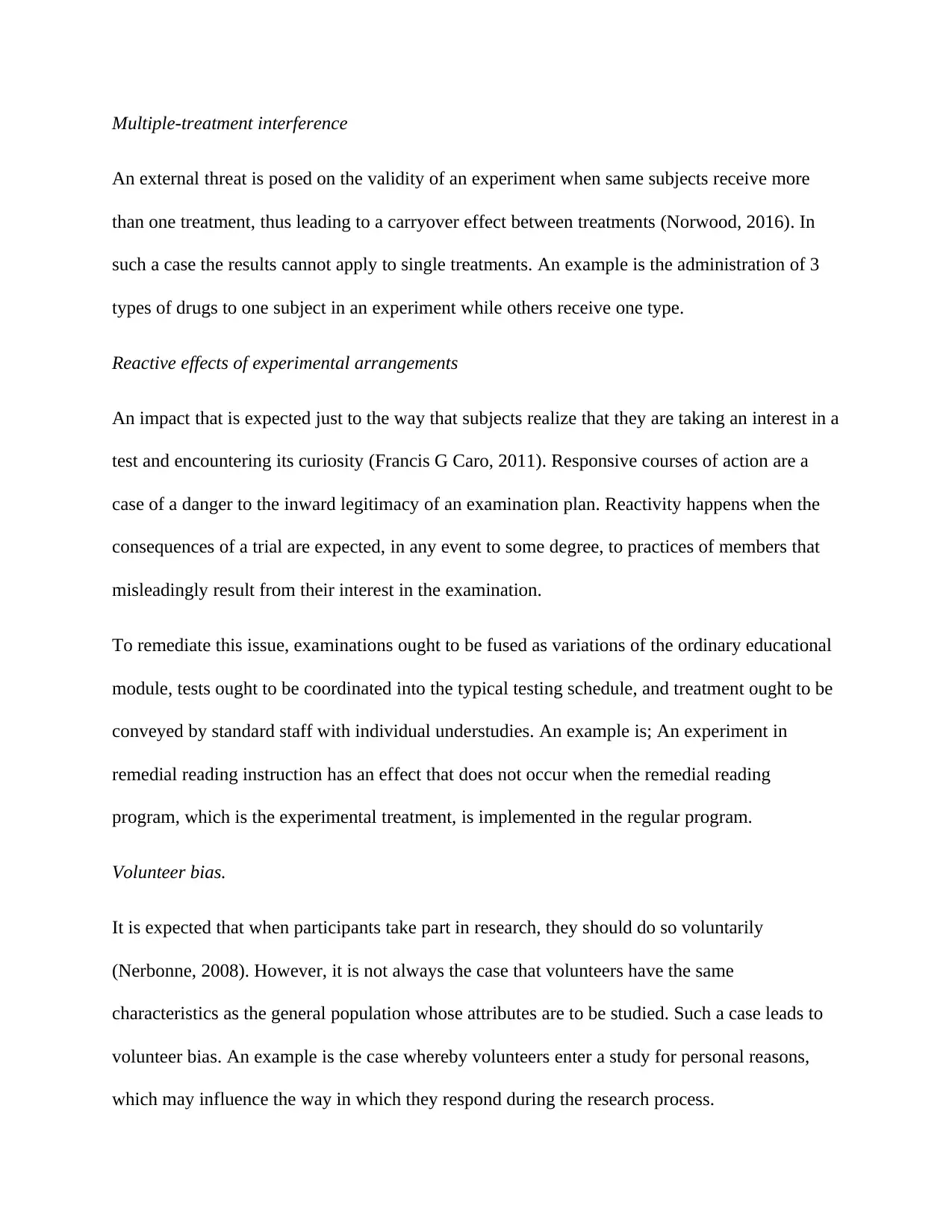
Multiple-treatment interference
An external threat is posed on the validity of an experiment when same subjects receive more
than one treatment, thus leading to a carryover effect between treatments (Norwood, 2016). In
such a case the results cannot apply to single treatments. An example is the administration of 3
types of drugs to one subject in an experiment while others receive one type.
Reactive effects of experimental arrangements
An impact that is expected just to the way that subjects realize that they are taking an interest in a
test and encountering its curiosity (Francis G Caro, 2011). Responsive courses of action are a
case of a danger to the inward legitimacy of an examination plan. Reactivity happens when the
consequences of a trial are expected, in any event to some degree, to practices of members that
misleadingly result from their interest in the examination.
To remediate this issue, examinations ought to be fused as variations of the ordinary educational
module, tests ought to be coordinated into the typical testing schedule, and treatment ought to be
conveyed by standard staff with individual understudies. An example is; An experiment in
remedial reading instruction has an effect that does not occur when the remedial reading
program, which is the experimental treatment, is implemented in the regular program.
Volunteer bias.
It is expected that when participants take part in research, they should do so voluntarily
(Nerbonne, 2008). However, it is not always the case that volunteers have the same
characteristics as the general population whose attributes are to be studied. Such a case leads to
volunteer bias. An example is the case whereby volunteers enter a study for personal reasons,
which may influence the way in which they respond during the research process.
An external threat is posed on the validity of an experiment when same subjects receive more
than one treatment, thus leading to a carryover effect between treatments (Norwood, 2016). In
such a case the results cannot apply to single treatments. An example is the administration of 3
types of drugs to one subject in an experiment while others receive one type.
Reactive effects of experimental arrangements
An impact that is expected just to the way that subjects realize that they are taking an interest in a
test and encountering its curiosity (Francis G Caro, 2011). Responsive courses of action are a
case of a danger to the inward legitimacy of an examination plan. Reactivity happens when the
consequences of a trial are expected, in any event to some degree, to practices of members that
misleadingly result from their interest in the examination.
To remediate this issue, examinations ought to be fused as variations of the ordinary educational
module, tests ought to be coordinated into the typical testing schedule, and treatment ought to be
conveyed by standard staff with individual understudies. An example is; An experiment in
remedial reading instruction has an effect that does not occur when the remedial reading
program, which is the experimental treatment, is implemented in the regular program.
Volunteer bias.
It is expected that when participants take part in research, they should do so voluntarily
(Nerbonne, 2008). However, it is not always the case that volunteers have the same
characteristics as the general population whose attributes are to be studied. Such a case leads to
volunteer bias. An example is the case whereby volunteers enter a study for personal reasons,
which may influence the way in which they respond during the research process.
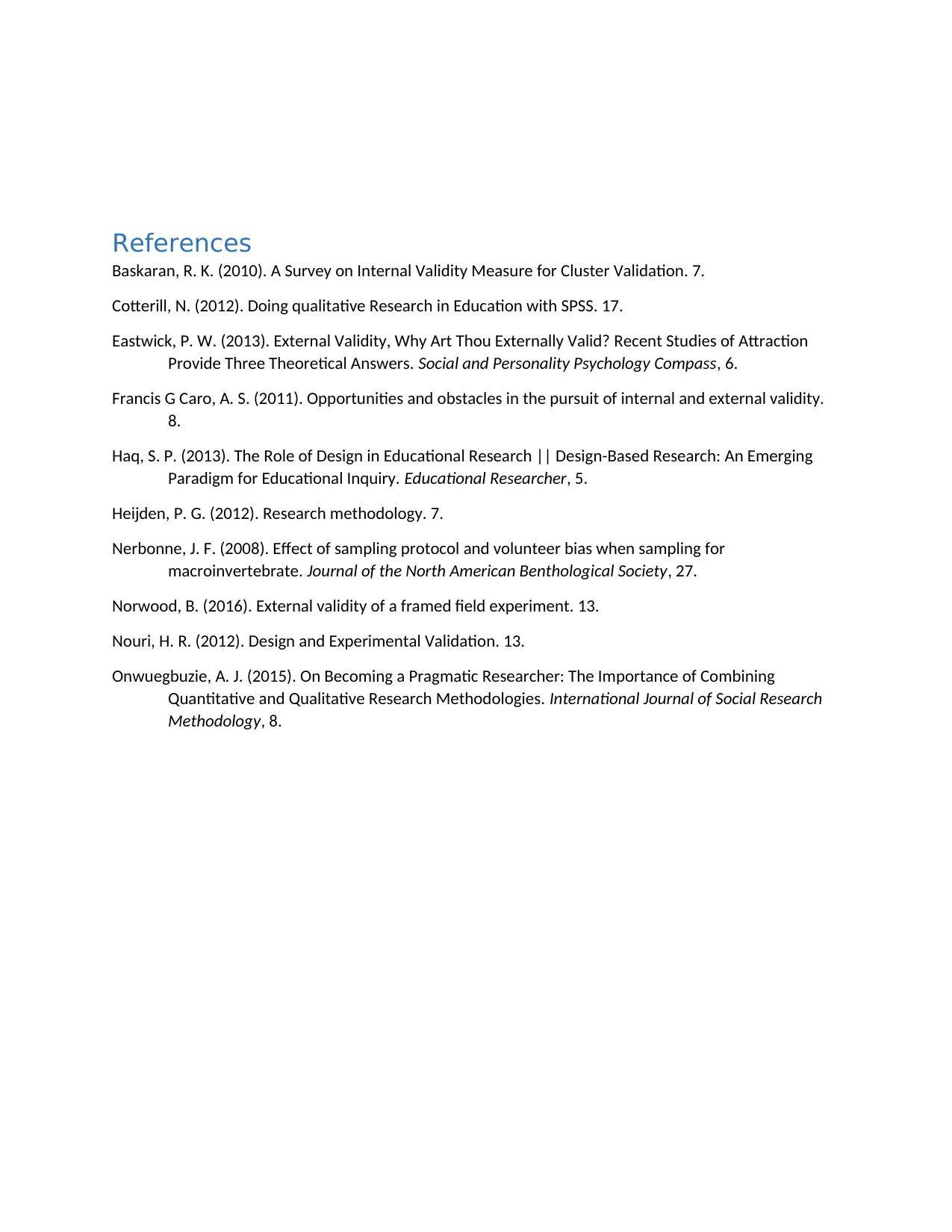
References
Baskaran, R. K. (2010). A Survey on Internal Validity Measure for Cluster Validation. 7.
Cotterill, N. (2012). Doing qualitative Research in Education with SPSS. 17.
Eastwick, P. W. (2013). External Validity, Why Art Thou Externally Valid? Recent Studies of Attraction
Provide Three Theoretical Answers. Social and Personality Psychology Compass, 6.
Francis G Caro, A. S. (2011). Opportunities and obstacles in the pursuit of internal and external validity.
8.
Haq, S. P. (2013). The Role of Design in Educational Research || Design-Based Research: An Emerging
Paradigm for Educational Inquiry. Educational Researcher, 5.
Heijden, P. G. (2012). Research methodology. 7.
Nerbonne, J. F. (2008). Effect of sampling protocol and volunteer bias when sampling for
macroinvertebrate. Journal of the North American Benthological Society, 27.
Norwood, B. (2016). External validity of a framed field experiment. 13.
Nouri, H. R. (2012). Design and Experimental Validation. 13.
Onwuegbuzie, A. J. (2015). On Becoming a Pragmatic Researcher: The Importance of Combining
Quantitative and Qualitative Research Methodologies. International Journal of Social Research
Methodology, 8.
Baskaran, R. K. (2010). A Survey on Internal Validity Measure for Cluster Validation. 7.
Cotterill, N. (2012). Doing qualitative Research in Education with SPSS. 17.
Eastwick, P. W. (2013). External Validity, Why Art Thou Externally Valid? Recent Studies of Attraction
Provide Three Theoretical Answers. Social and Personality Psychology Compass, 6.
Francis G Caro, A. S. (2011). Opportunities and obstacles in the pursuit of internal and external validity.
8.
Haq, S. P. (2013). The Role of Design in Educational Research || Design-Based Research: An Emerging
Paradigm for Educational Inquiry. Educational Researcher, 5.
Heijden, P. G. (2012). Research methodology. 7.
Nerbonne, J. F. (2008). Effect of sampling protocol and volunteer bias when sampling for
macroinvertebrate. Journal of the North American Benthological Society, 27.
Norwood, B. (2016). External validity of a framed field experiment. 13.
Nouri, H. R. (2012). Design and Experimental Validation. 13.
Onwuegbuzie, A. J. (2015). On Becoming a Pragmatic Researcher: The Importance of Combining
Quantitative and Qualitative Research Methodologies. International Journal of Social Research
Methodology, 8.
⊘ This is a preview!⊘
Do you want full access?
Subscribe today to unlock all pages.

Trusted by 1+ million students worldwide
1 out of 12
Related Documents
Your All-in-One AI-Powered Toolkit for Academic Success.
+13062052269
info@desklib.com
Available 24*7 on WhatsApp / Email
![[object Object]](/_next/static/media/star-bottom.7253800d.svg)
Unlock your academic potential
Copyright © 2020–2025 A2Z Services. All Rights Reserved. Developed and managed by ZUCOL.




